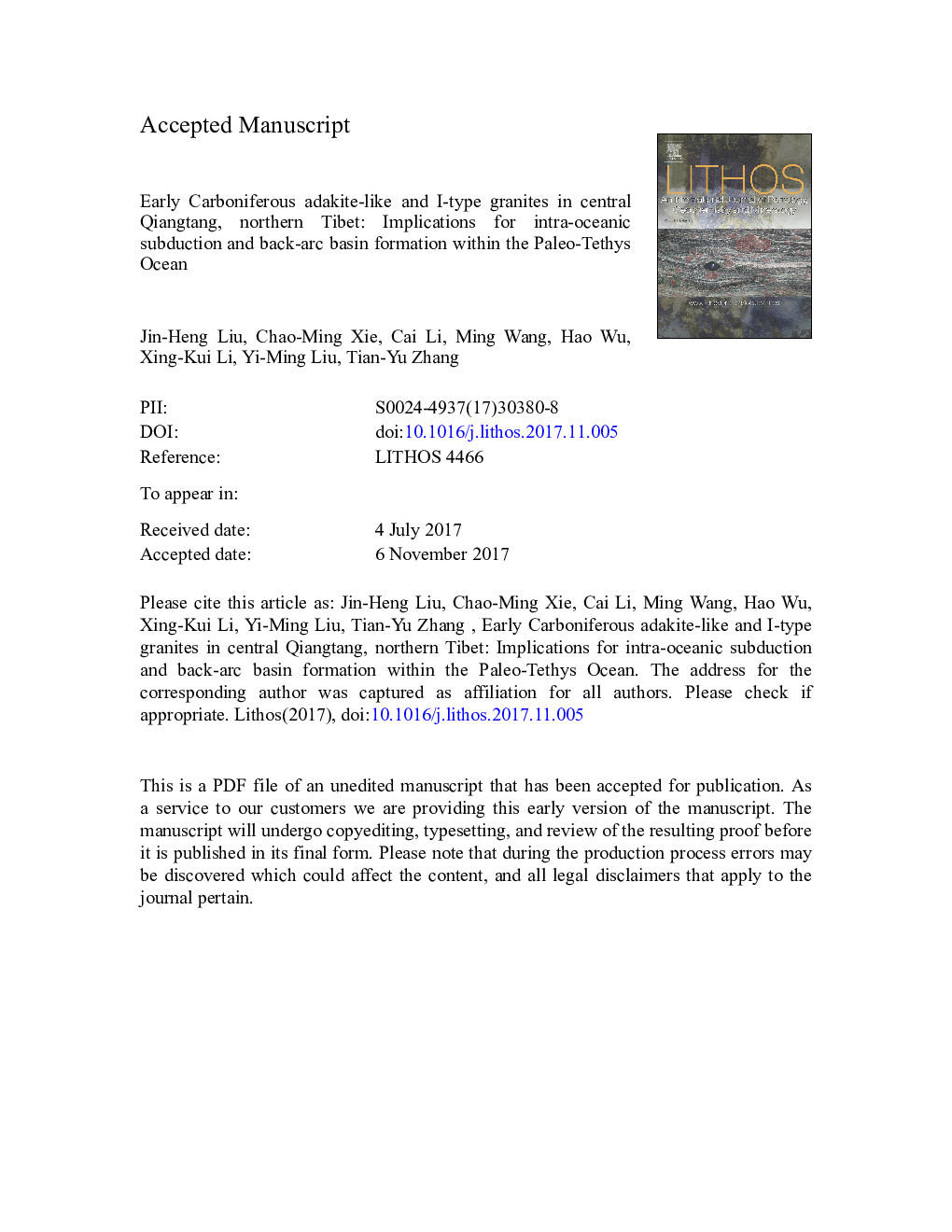| کد مقاله | کد نشریه | سال انتشار | مقاله انگلیسی | نسخه تمام متن |
|---|---|---|---|---|
| 8911804 | 1638624 | 2018 | 55 صفحه PDF | دانلود رایگان |
عنوان انگلیسی مقاله ISI
Early Carboniferous adakite-like and I-type granites in central Qiangtang, northern Tibet: Implications for intra-oceanic subduction and back-arc basin formation within the Paleo-Tethys Ocean
دانلود مقاله + سفارش ترجمه
دانلود مقاله ISI انگلیسی
رایگان برای ایرانیان
کلمات کلیدی
موضوعات مرتبط
مهندسی و علوم پایه
علوم زمین و سیارات
ژئوشیمی و پترولوژی
پیش نمایش صفحه اول مقاله

چکیده انگلیسی
Recent studies have proposed that the Late Devonian ophiolites in the central Qiangtang region of northern Tibet were formed in an oceanic back-arc basin setting, which has led to controversy over the subduction setting of the Longmucuo-Shuanghu-Lancangjiang Suture Zone (LSLSZ) during the Late Devonian to Early Carboniferous. In this paper we present new data about a suite of granite plutons that intrude into ophiolite in central Qiangtang. Our aim was to identify the type of subduction and to clarify the existence of an intra-oceanic back-arc basin in the LSLSZ during the Late Devonian to Early Carboniferous. The suite of granites consists of monzogranites, syenogranites, and granodiorites. Our laser ablation-inductively coupled plasma-mass spectrometry zircon U-Pb data yielded Early Carboniferous crystallization ages of 357.2Â Ma, 357.4Â Ma and 351.1Â Ma. We subsequently investigated the petrogenesis and tectonic setting of these granites based on their geochemical and Hf isotopic characteristics. First, we divided the granites into high Sr/Y (HSG) and low Sr/Y granites (LSG). The HSG group contains monzogranites and granodiorites that have similar geochemical characteristics to adakites (i.e., high Sr/Y and La/Yb ratios, low MgO, Y, and Yb contents, and no pronounced negative Eu anomaly), although they have slightly lower Sr and Al2O3 contents, caused by crystal fractionation during late magmatic evolution. Therefore, we define the HSG group as adakite-like granites. The study of the HSG shows that they are adakite-like granites formed by partial melting of oceanic crust and experience fractional crystallization process during late evolution. However, some differences between the monzogranites and granodiorites indicate that there are varying degree contributions of subducted sediments during diagenesis. The LSG group contains syenogranites that have distinct negative correlations between their P2O5 and SiO2 contents, and Y and Th contents have significant positive correlations with Rb. The above characteristics indicate that the syenogranites are typical I-type granites. The results of this study also show that the LSG were produced by magma mixing between the mantle and juvenile oceanic crust. The field study found that the Early Carboniferous suite of granites intruded into contemporaneous ophiolites that formed in an intra-oceanic back-arc basin, and were associated with coeval A-type granites in this region. Based on the geochemical and isotopic data presented in this paper and regional geological data, we consider that the HSG were formed during intra-oceanic subduction of the Paleo-Tethys Ocean in the Early Carboniferous. The LSG and A-type granites were formed in an intra-oceanic back-arc basin setting caused by roll-back of the Paleo-Tethys Ocean slab. This confirms that the subduction of the Paleo-Tethys Ocean in the Early Carboniferous was intra-oceanic subduction, and provides important evidence for the existence of an intra-oceanic back-arc basin during the Late Devonian to Early Carboniferous.
ناشر
Database: Elsevier - ScienceDirect (ساینس دایرکت)
Journal: Lithos - Volumes 296â299, January 2018, Pages 265-280
Journal: Lithos - Volumes 296â299, January 2018, Pages 265-280
نویسندگان
Jin-Heng Liu, Chao-Ming Xie, Cai Li, Ming Wang, Hao Wu, Xing-Kui Li, Yi-Ming Liu, Tian-Yu Zhang,